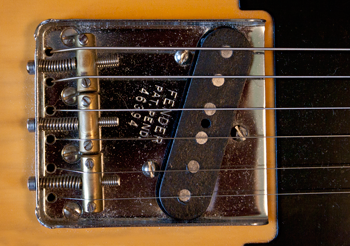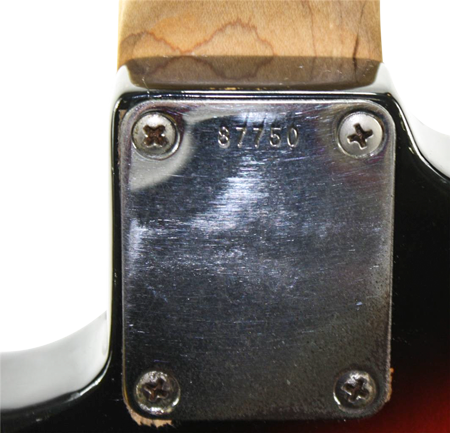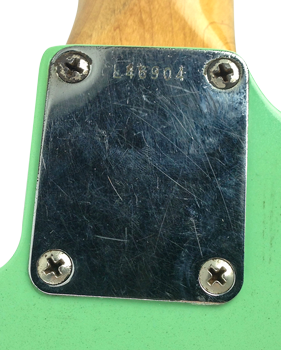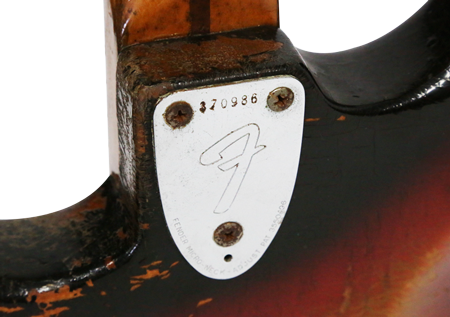Where do I find my Fender Serial Number?
 This article is intended to help you date your Fender Stratocaster, Telecaster, and Precision Bass guitars all the way back to the early 1950s. In order to tell how old your Fender is you will have to find the indentification number or neck number. The serial number location has changed a few times of the years. From 1950 to 1954 Fender guitar unique numbers were stamped in the bridge cavity cover plate. From 1954 to 1976 Fender stamped its guitar’s serial number on either the top or bottom of the neck plate. Modern Fender production guitars, 1976 to the present, have their ID numbers on the front or back of the headstock near the Fender decal. In 1982 Fender decided to start making reissued vintage guitars. These guitars were replicas of the early 1950 and 1960s era guitars. True to form the reissue guitars have their indentification numbers stamped in the neck plate.
This article is intended to help you date your Fender Stratocaster, Telecaster, and Precision Bass guitars all the way back to the early 1950s. In order to tell how old your Fender is you will have to find the indentification number or neck number. The serial number location has changed a few times of the years. From 1950 to 1954 Fender guitar unique numbers were stamped in the bridge cavity cover plate. From 1954 to 1976 Fender stamped its guitar’s serial number on either the top or bottom of the neck plate. Modern Fender production guitars, 1976 to the present, have their ID numbers on the front or back of the headstock near the Fender decal. In 1982 Fender decided to start making reissued vintage guitars. These guitars were replicas of the early 1950 and 1960s era guitars. True to form the reissue guitars have their indentification numbers stamped in the neck plate.
The serial numbers on the outside of the body are not the only way to date a Fender guitar however. Fender also dated the neck when it was manufactured. After the neck was finished, a Fender employee would either stamp or handwrite the date on the end of the guitar neck on its heel. This marking is only visible when the neck is removed from the body because it is covered in the neck pocket. Almost all Fender guitars have a dated neck. Some Fender guitar bodies and pickups also have dates written on them. Few Fender guitars have dates written on the bodies under the pickups, in the routed out cavities, and near the wiring harnesses. Fender only decided to write dates on the bodies for a few years here and there. They never really did that consistently.
What does the date on the neck mean?
Many people think that the date on the heel of their Fender neck is the production date of the guitar. After reviewing the ID number, you might find out that the two corresponding dates don’t coincide. Why is this? It all has to do with how Fender produced guitars. Leo Fender was a genius with minimizing the costs of production. Unlike Gibson, Leo found did everything the cheapest and fastest way possible. He made a bolt-on neck, so the neck and the body could be manufactured at the same time. He wired the pickguard with pickups, so all the wiring could be finished before the body was even dry from finishing. That’s how the Fender production line worked. The number and date on the neck is simply the date that the neck was finished–not the date that the guitar was completed. Necks could sit for days, weeks, or even months at a time before being matched with a body. After the entire guitar was assembled, the indentification number was stamped in place. Being many months later, the serial number date and the neck date might not match. Remember, these serial and neck numbers were never really intended for historical dating. They were simply internal numbers to help with production.
Fender Serial Number Guide
Now that we have talked about where to find your Fender guitar ID number and what it means, here is the Fender serial number database that I have compiled. It includes most of the Fender serial numbers issued along with the corresponding dates and a short history of Fender Guitars through the years.
1950-1954 Fender Guitar Serial Numbers
When Leo first started putting indentification numbers on his guitars, he segregated them by model. Each models unique numbers started at 1 or a number close to it. That means that there could be a Tele, Strat, and Precision bass with the exact same serial number. He didn’t stop doing this until after 1954.
| Numbers | Years |
|---|---|
| 33-860 | 1950-1952 |
| 0005-0746 | 1950-1952 |
| 0748-1331 | 1951-1952 |
| 0161-0470 | 1951-1952 |
| 2911-5368 | 1951-1954 |
| Numbers | Years |
|---|---|
| 0-6000 | 1954 |
| Numbers | Years |
|---|---|
| 161-357 | 1951 |
| 299-619 | 1952 |
| 0001-0160 | 1952 |
| 0161-0470 | 1951-1952 |
| 0475-0840 | 1952-1953 |
| 0848-1897 | 1953-1954 |
1954-1963 Fender Guitar Serial Numbers
 At some point in 1954, Fender decided to stop grouping the guitar ID number by model. He started using one sequence of serial numbers for all the guitars coming off of the Fender production lines including Teles, Esquires, Strats, and P-basses. Some of these indentification numbers are still out of sequence, jumbled up, or missing. You may notice that there is a great deal of over lapping numbers in these nine years. The only way to verify an over lapping date is to check the corresponding neck date and body date. This list is a little convoluted because there are so many over lapping serial numbers. The number column represents the general number grouping that Fender and most experts agree on. The low and high columns show the range of indentification numbers that have been positively matched to specific years. As you can see, there is quite a bit of overlap. For some reason during 1955, 1957, and 1958 Fender decided to place zero or a dash in front of ID numbers periodically. Some guitars in these years have them and some don’t.
At some point in 1954, Fender decided to stop grouping the guitar ID number by model. He started using one sequence of serial numbers for all the guitars coming off of the Fender production lines including Teles, Esquires, Strats, and P-basses. Some of these indentification numbers are still out of sequence, jumbled up, or missing. You may notice that there is a great deal of over lapping numbers in these nine years. The only way to verify an over lapping date is to check the corresponding neck date and body date. This list is a little convoluted because there are so many over lapping serial numbers. The number column represents the general number grouping that Fender and most experts agree on. The low and high columns show the range of indentification numbers that have been positively matched to specific years. As you can see, there is quite a bit of overlap. For some reason during 1955, 1957, and 1958 Fender decided to place zero or a dash in front of ID numbers periodically. Some guitars in these years have them and some don’t.
| Numbers | Low | High | Years |
|---|---|---|---|
| 0001-6999 | 0001 | 10146 | 1954 |
| 7000-8999 | 3152 | 10798 | 1955 |
| 09000-16999 | 7895 | 16957 | 1956 |
| 17000-24999 | 10604 | 28522 | 1957 |
| 25000-33999 | 022878 | 51593 | 1958 |
| 34000-43999 | 022878 | 51593 | 1959 |
| 44000-58999 | 39993 | 66626 | 1960 |
| 59000-70999 | 55531 | 77754 | 1961 |
| 71000-93999 | 69520 | 96203 | 1962 |
| 94000-99999 | 81977 | 99924 | 1963 |
Late 1962 – Early 1965 Fender Guitar Serial Numbers

Toward the end of 1962 Fender’s success kept on building. He was nearing his 100,000th guitar. Instead of adding another digit on to his 5-digit ID numbers, Leo decided to add an “L”, presumably for his first initial, in front of the serial numbers and start the sequence all over again. This time all the indentification numbers under 10,000 fill the empty digits with zeros. For example, the 989th guitar’s ID number would not be L989. It was L00989. Since this change wasn’t until the end of 1962, only a few true 1962 Fenders have an “L” serial number.
| Numbers | Low | High | Years |
|---|---|---|---|
| L00001-L19999 | L0001 | L60330 | 1963 |
| L20000-L59999 | L08825 | L92560 | 1964 |
| L60000-L99999 | L23537 | L99944 | 1965 |
1965-1976 Fender Guitar Serial Numbers
 In early 1965, Leo Fender sold Fender Musical Instruments, Inc. to CBS for $13 million. A lot of changes happened to the company as well as the guitars themselves under the new ownership. The indentification number sequences were no exception. CBS came up with a new numbering system to take advantage of the fact that Leo did not use 6-digit ID numbers. CBS continued the sequence Fender started in 1954. These 1965-1976 era guitars are commonly referred to as the F series because of the neck plate design change. The new neck plate only had the Fender F logo stamped in place.
In early 1965, Leo Fender sold Fender Musical Instruments, Inc. to CBS for $13 million. A lot of changes happened to the company as well as the guitars themselves under the new ownership. The indentification number sequences were no exception. CBS came up with a new numbering system to take advantage of the fact that Leo did not use 6-digit ID numbers. CBS continued the sequence Fender started in 1954. These 1965-1976 era guitars are commonly referred to as the F series because of the neck plate design change. The new neck plate only had the Fender F logo stamped in place.
| Numbers | Low | High | Years |
|---|---|---|---|
| 100000-119999 | 100173 | 158977 | 1965 |
| 120000-179999 | 100173 | 158977 | 1966 |
| 180000-219999 | 112172 | 261343 | 1967 |
| 220000-251999 | 156657 | 263115 | 1968 |
| 252000-291999 | 204352 | 262774 | 1969 |
| 292000-298999 | 224160 | 290835 | 1970 |
| 290000-344999 | 278916 | 304089 | 1971 |
| 345000-379999 | 261863 | 331031 | 1972 |
| 380000-539999 | 258495 | 654030 | 1973 |
| 540000-599999 | 316987 | 602615 | 1974 |
| 600000-656999 | 417024 | 677199 | 1975 |
| 657000-669999 | 595121 | 717257 | 1976 |
| 670000-799999 | 1971-1976 |
1976-Present USA Fender Guitar Serial Numbers
In 1976, Fender decided to stop stamping ID numbers in guitar parts and started making decals for the guitar peghead or headstock. Along with the new location a new series of serial numbers were instituted. Fender apparently was thinking long term because they developed a serial numbering system with one-letter codes preceding the indentification numbers. The letters referred to the decade that the guitars were produced. Most guitars then had a number following the one-letter code that designated the specific year. For instance, ID number S76823 would be a guitar produced in 1977. In about 1982 Fender started making import guitars from Japan and around 1990 Fender started importing from Mexico. These guitars have a completely different set of serial numbers that I will talk about later in the article. This section only deals with USA made Fender guitars. Here are the decade numbers:
| Letters | Decades |
|---|---|
| S | 1970’s |
| E | 1980’s |
| N | 1990’s |
| Z | 2000’s |
 The new serial number system was a little complicated, but it does make it relatively easy to tell the date of the guitar. Like all Fender’s previous systems, they are problems with this one. Fender mass-produced the headstock decal without matching them with the annual production schedules of the guitars–meaning they made more decals for a given year than guitars. See the problem? There were a few years where excess headstock ID number decals were produced and held over to the next year, the some guitars are actually dated with a previous year decal. It wasn’t until 1991 that Fender actually got this system straighten out. To get the exact date on guitars made between 1976 and 1991, it is important to cross-reference the dates on the neck written on the heel. Here are a list of dates and codes that overlap years.
The new serial number system was a little complicated, but it does make it relatively easy to tell the date of the guitar. Like all Fender’s previous systems, they are problems with this one. Fender mass-produced the headstock decal without matching them with the annual production schedules of the guitars–meaning they made more decals for a given year than guitars. See the problem? There were a few years where excess headstock ID number decals were produced and held over to the next year, the some guitars are actually dated with a previous year decal. It wasn’t until 1991 that Fender actually got this system straighten out. To get the exact date on guitars made between 1976 and 1991, it is important to cross-reference the dates on the neck written on the heel. Here are a list of dates and codes that overlap years.
| Letters | Decades |
|---|---|
| S7 | January 1977 – April 1978 |
| S8 | December 1977 – December 1978 |
| S9 | November 1978 – August 1981 |
| E0 | June 1979 – December 1981 |
| E1 | December 1980 – January 1982 |
| E2 | December 1981 – January 1983 |
| E3 | December 1982 – January 1985 |
| E4 | December 1983 – Early 1988 |
| E8 | 1988 – 1989 |
| E9 | 1989 – 1990 |
| N9 | 1990 |
| N0 | 1990 – 1991 |
Aside from all of the errors and overlapping serial numbers, this system was quite improved from the previous ID number systems. If Fender would have executed the indentification numbers as planned, USA Fender guitars would be numbered as the following without any exceptions. You can use this table to lookup your Fender serial number after 1976.
| Numbers | Years |
|---|---|
| 760000-799999 | 1976-1977 |
| 800000-899999 | 1979-1981 |
| 1000000-8999999 | 1976-1981 |
| S100000-S699999 | 1979-1982 |
| S700000-S779999 | 1977 |
| S740000-S899999 | 1978 |
| S810000-S879999 | 1979 |
| S880000-S989999 | 1980 |
| S950000-S999999 | 1981 |
| E000000-E199999 | 1979-1982 |
| E110000-E129999 | 1980-1983 |
| E200000-E299999 | 1982 |
| E300000-E319999 | 1983 |
| E320000-E399999 | 1984-1985 |
| E400000-E499999 | 1984-1985, 1987 |
| E800000-E899999 | 1988-1989 |
| E900000-E999999 | 1989-1990 |
| N900000-N999999 | 1990 |
| N000000-N099999 | 1990 |
| N100000-N199999 | 1991-1992 |
| N200000-N299999 | 1992-1993 |
| N300000-N399999 | 1993-1994 |
| N400000-N499999 | 1994-1995 |
| N500000-N599999 | 1995-1996 |
| N600000-N699999 | 1996-1997 |
| N700000-N799999 | 1997-1998 |
| N800000-N899999 | 1998-1999 |
| N900000-N999999 | 1999-2000 |
| Z000000-Z099999 | 2000-2001 |
| Z100000-Z199999 | 2001-2002 |
| Z200000-Z299999 | 2002-2003 |
| Z300000-Z399999 | 2003-2004 |
| Z400000-Z499999 | 2004-2005 |
| Z500000-Z599999 | 2005-2006 |
| Z600000-Z699999 | 2006-2007 |
| Z700000-Z799999 | 2007-2008 |
| Z800000-Z899999 | 2008-2009 |
| Z900000-Z999999 | 2009-2010 |
| 1000000-1099999 | Early 2010 |
| US1000000-US1099999 | Late 2010 |
| US1100000-US1199999 | 2011 |
Fender Anniversary, Reissue,
Special Edition, and Signature Series
Throughout the years, Fender has run many limited edition, reissue, and custom guitars. All of these guitars’ ID numbers do not follow the unique number sequence of the regular production guitars. These guitars usually have a special two to four letter prefix before the serial number. Each prefix is unique to that model guitar. Here is a guide to lookup all of the different types of special Fender guitars with their own serial number pattern.
| Prefix | Number of Digits | Example Serial Number | Guitar Model | Years |
|---|---|---|---|---|
| 25 | 5 | 2500001 | 25th Anniversary Stratocaster | 1979-1980 |
| AMXN | 6 | AMXN000001 | California Series | 1997-1998 |
| C | 6 | C000001 | Collector’s Series | Up until 1965 |
| CA | 5 | CA00001 | Stratocaster Gold | 1981-1983 |
| CB | 5 | CB00001 | Precision Bass Special and Jazz Bass Gold | 1981, 1982 |
| CC | 5 | CC00001 | Stratocaster Walnut | 1981-1983 |
| CD | 5 | CD00001 | Precision Bass Special | 1982 |
| CE | 5 | CE00001 | Precision Bass Special, Black and Gold Telecaster | 1981-1983 |
| CN | See Korean Guitars | |||
| CO | 5 | CO00001 | Precision Bass Special | 1982 |
| D | 6 | D000001 | Jazz Bass | 1981-1982 |
| DN | 6 | DN000001 | American Deluxe Series | 1998-1999 |
| DZ | 1 year digit + 5 or 6 | DZ100001 | American Deluxe Series | 2000-present |
| FN | 6 | FN000001 | USA Guitars made for export | Can’t be determined from SN |
| G | 6 | G000001 | The Strat | 1980-1983 |
| GO | 5 | GO00001 | Precision Bass Special and Stratocaster Gold | 1982, 1982-1983 |
| I | 6 | I00001 | USA guitars for export stamped USA on heel | 1989-1990 |
| LE | 6 | LE000001 | Blonde Jaguar and Jassmaster sold as set with Blonde Deluxe Reverb Amp | 1994 |
| MN | Mexican Fender Serial Numbers | |||
| NC | See Squire Guitars | |||
| SE | 6 | SE000001 | Signature Models | 1980’s – 1st digit designates specific year |
| SN | 6 | SN000001 | Signature Models | 1990’s – 1st digit designates specific year |
| SZ | 6 | SZ000001 | Signature Models | 2000’s – 1st digit designates specific year |
| T | 6 | T000001 | Fender Tribute Series | Check Heel of Neck |
| V | 4, 5, or 6 | V000001 | Vintage Reissue Guitars Except Tele ’52 | Introduced in 1982 Check Neck for Year |
| VN | Korean Fender Serial Numbers | |||
| XN | 5 | XN00001 | FRS and Telecaster ’52 | More variations of serials may exist |
| XXX of 500 | 3 | 001 of 500 | 35th Anniversary Stratocaster | 1989-1990 |
| XXXX on Bridgeplate | 4 | 0001 | U.S. ’52 Vintage Telecaster Reissue | 1982-1988 Check Neck for Year |
| XXXXX on Bridgeplate | 5 | 00001 | U.S. ’52 Vintage Telecaster Reissue | 1988-present Check Neck for Year |
| XXXX on Back of Headstock | 4 | 0001 | Custom Order | 1987-present Check Neck for Year |
